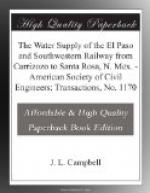The plant is lighted by a small, but very complete, engine and dynamo on one base and run by steam from the Sterling boilers.
The two plants are exactly alike throughout.
Reservoir Leakage.—The Nogal Reservoir basin is covered with from 2 to 5 ft. of good clay, except where it is punctured by a dike, or washed down to the underlying sandstone by a few gullies. These punctures or washes were covered or filled with clay from 1 to 4 ft. deep. During the first season the leakage, above the 6-ft. contour, was at the rate of 2 in. per day.
As the water fell, due to leakage, evaporation, and use, a herd of from 300 to 400 cattle were worked around the shore line. This reduced the leakage to 3/8 in. below 8 ft., and to nothing below 6 ft., above the outlet. As the flow line rises higher each season, the puddling will be continued to the top. The leakage at 12 ft. above the outlet, or 17 ft. above the bottom, is still approximately 1 in. per day. The total puddling, to date, covering two seasons, is equivalent to 11,150 days’ work of one cow, and covers an area of 1,500,000 sq. ft.
The clay packed densely, the final hoof marks being not more than 1/4 in. deep and remaining distinct under the water around the shore line for one year. Apparently, the reservoir will finally become water-tight at all elevations.
The soil in which the four service reservoirs on the railway are built proved to be about the worst for such work. In its natural state on the prairie, after the excavation for the reservoir was completed, it filtered water at the rate of 3 ft. per day. Tamping and puddling still left a filtration of 12 in. per day, with a tendency to increase. Enough water filtered through the concrete to produce settlement and cracks. Finally, the concrete was water-proofed with two coats of soap, two of alum, and one of asphalt. This has made all the reservoirs water-tight. Elaterite, an asphalt paint made by the Elaterite Paint and Manufacturing Company, of Des Moines, Iowa, was used successfully on the Luna Reservoir. This paint is applied cold, and preliminary tests showed it to be quite efficient.
The analysis of the soil is as follows:
Loss on ignition 3.35
Silica 56.36
Oxide of iron 2.93
Oxide of aluminum 8.97
Calcium oxide 15.95
Magnesium oxide 0.98
Oxides of sodium and potassium 0.47
Carbonic acid 11.35
Sulphuric acid 0.11
Chlorine 0.04
Manganese Traces
------
100.51
Insoluble matter, 64.50 per cent.
Pipe-Line Leakage.—There is no measurable leakage from the iron pipe. By thorough inspection and measurement at the end of two years, leakage on the wood pipe, between Coyote and Bonito Creek, from the 11-and 12-in. pipe, was found to be as follows:




